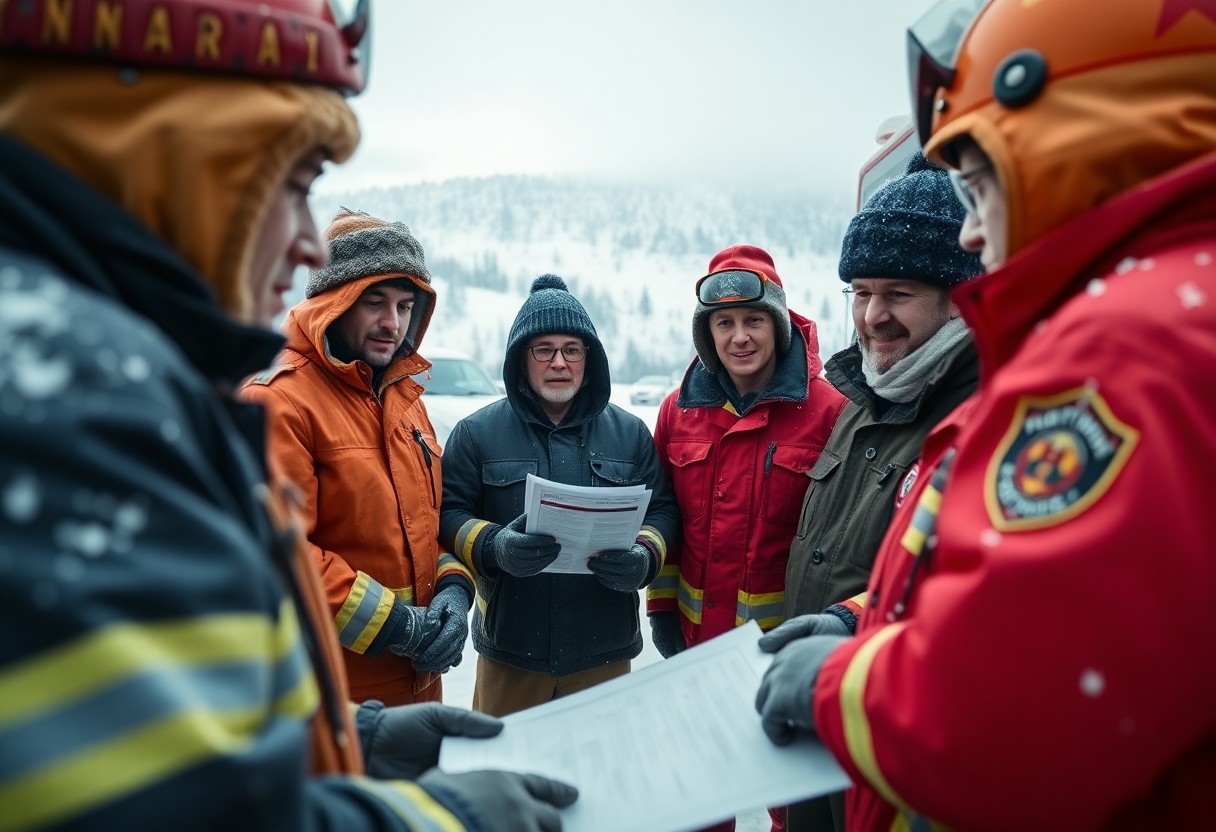There’s no doubt that winter poses unique challenges for your community’s safety as a volunteer fire department. With cold temperatures, heavy snowfall, and potentially hazardous conditions, it’s imperative for you to implement effective strategies to enhance emergency preparedness. This guide offers practical tips and insights to help you ensure your team is ready to respond swiftly and effectively during winter emergencies, keeping your community safe and informed throughout the season.
Understanding Community Emergency Preparedness
While emergency situations can strike at any moment, understanding community emergency preparedness is key to maintaining safety and resilience. This means being equipped with the knowledge and resources needed to effectively respond to various emergencies, from natural disasters to health crises. By fostering a culture of preparedness within your fire department and the broader community, you can significantly improve response times and enhance overall safety. Prioritizing education and outreach about emergency protocols ensures that both you and your community are ready to face any challenge that may arise this winter.
Importance of Preparedness
Assuming your community is prepared is a dangerous gamble. With winter weather posing numerous risks, having a solid emergency plan can save lives and reduce panic in critical situations. Preparedness enables everyone to effectively contribute to response efforts, empowering individuals and organizations to remain calm and focused when faced with emergencies. By actively promoting and engaging in preparedness initiatives, you set a strong foundation for community resilience and safety.
Factors Affecting Emergency Readiness
Now, there are several factors that can significantly affect your community’s emergency readiness. These include the level of public awareness, availability of resources, and the overall infrastructure in place to support emergency operations. Important elements to consider include:
- Community education programs about emergency response.
- Resource availability, such as equipment and trained personnel.
- Infrastructure that facilitates efficient emergency communication.
Thou must assess these aspects regularly to strengthen preparedness.
Preparedness is an ongoing process that requires your active involvement and commitment. Analyzing local conditions and resources helps identify areas for improvement and adaptations needed to enhance overall readiness. Additional factors include:
- Regular training sessions for volunteers and responders.
- Partnerships with local organizations and agencies.
- Accessibility to emergency resources for all community members.
Thou hold the key to fostering a well-prepared community, taking every step necessary to ensure safety and response effectiveness.
How to Assess Community Risks
Clearly, assessing community risks is an important step for volunteer fire departments in preparing for winter emergencies. Start by reviewing historical data on natural disasters and incidents in your area. This will give you insight into which types of events pose the greatest threats. Engage with local agencies, conduct surveys, and utilize local knowledge to compile a comprehensive risk assessment. Prioritize areas based on vulnerability, and use this information to tailor your response plans effectively.
Identifying Vulnerable Areas
Assuming you want to optimize your emergency preparedness, identifying vulnerable areas in your community is key. Focus on regions prone to severe weather, outdated infrastructure, and those with high population density. This helps target resources where they are needed most to protect lives and property during emergencies.
Engaging Community Members
Community involvement is vital for enhancing your disaster readiness. By engaging community members, you can raise awareness about potential risks and foster a culture of preparedness. Encourage participation through meetings, workshops, and volunteer opportunities. Building trust ensures that your fire department can effectively mobilize and coordinate efforts during a crisis.
Plus, actively engaging community members not only strengthens relationships but also encourages them to take an active role in emergency preparedness. Conducting training sessions and simulations can empower residents to be prepared for potential hazards. By fostering a sense of ownership over their safety, you create a stronger, more resilient community that responds effectively in the face of emergencies, ultimately keeping everyone safer this winter.
How to Develop a Proactive Emergency Plan
Some volunteer fire departments overlook the importance of having a well-structured emergency plan. By prioritizing the development of a proactive emergency plan, you can enhance your community’s readiness for unexpected events this winter. This involves assessing potential risks, determining resources, and implementing strategies to mitigate these dangers.
Creating a Comprehensive Plan
Emergency preparedness requires a detailed assessment of local hazards and the creation of a plan that addresses each scenario. Involve community members and local agencies to ensure a thorough understanding of existing vulnerabilities. Also, routinely update your plan based on seasonal changes, new resources, or shifts in community demographics to keep it relevant.
Establishing Clear Communication Channels
To ensure effective response during emergencies, establish clear communication channels among your team and with the community. This can involve utilizing both traditional methods, like radios, and modern tools, such as social media alerts. By doing so, you enhance your ability to disseminate critical information promptly.
Comprehensive communication is vital for the success of your emergency plan. You should develop a network that not only includes fire department personnel but also integrates local authorities, community leaders, and emergency services. Establishing a multi-faceted communication strategy ensures that everyone is informed and coordinating efficiently during emergencies, ultimately leading to a safer community.
Tips for Effective Training for Volunteers
For volunteer fire departments, effective training is key to successful community emergency preparedness. Focus on fostering skills and knowledge among your volunteers through:
- Consistent training schedules
- Hands-on experience
- Crisis scenarios
- Team-building exercises
Perceiving training as an ongoing commitment will empower your volunteers and enhance your department’s overall readiness.
Regular Training Sessions
Little effort in scheduling regular training sessions can yield great benefits for your team. Consider setting up a calendar to ensure volunteers remain engaged and current with emergency protocols. This fosters a sense of unity and readiness, allowing everyone to understand their roles clearly.
Utilizing Simulations and Drills
Utilizing simulations and drills can significantly improve your fire department’s preparedness for emergencies. These hands-on activities immerse your volunteers in realistic scenarios, allowing them to practice their skills in a controlled environment. For instance, by organizing a mock fire response, you create an opportunity for your team to experience the intensity and urgency of real situations without the consequences. This type of training not only builds confidence but also hones your team’s response time and decision-making skills, which are vital during actual emergencies. Implementing these practices increases your department’s effectiveness and enhances community safety.
How to Implement Winter-Specific Safety Measures
After assessing the unique challenges of winter weather, you must develop and implement tailored safety measures for your volunteer fire department. These could include setting up a training program focused on dealing with snow and ice, ensuring all equipment is winter-ready, and establishing protocols for winter response during the colder months. Make sure that all team members are familiar with these guidelines to enhance preparedness and minimize risks in your community.
Addressing Seasonal Hazards
WinterSpecific hazards, such as snow accumulation and ice, increase the risk of accidents and emergencies. You should conduct regular assessments of your area to identify hotspots for potential hazards, and develop plans to manage or mitigate these risks. Ensure that your community knows how to report issues like icy roads or downed power lines, enabling quicker response times.
Collaborating with Local Agencies
Even during winter, establishing a collaborative relationship with local emergency agencies can enhance your department’s effectiveness. Use this opportunity to develop mutual aid agreements and share resources such as equipment, personnel, and training sessions. Building bridges with these agencies can ensure a coordinated response to any winter emergencies.
Collaborating with local agencies not only strengthens your emergency response but also builds a network of support in your community. Engaging with local law enforcement, public works, and health departments allows you to leverage their expertise in assessing risks and deploying resources. Together, you can create a unified response plan that addresses the unique challenges of winter emergencies, ensuring that your department is not alone in facing potential crises. This shared accountability fosters community resilience and strengthens overall preparedness.
Tips for Community Engagement and Awareness
Now is the time to enhance your community’s knowledge about emergency preparedness this winter. Engage residents with clear communication and practical guidance by introducing effective outreach strategies, including:
- Host engaging community meetings
- Distribute informative materials
- Collaborate with local organizations
- Create interactive events that involve families
Assume that fostering a collaborative environment can significantly improve your community’s readiness for winter emergencies.
Organizing Informational Workshops
You can significantly elevate community awareness by organizing comprehensive informational workshops. These sessions can cover vital topics, such as winter safety tips, emergency response procedures, and local resources. By facilitating hands-on activities, you empower participants to apply what they’ve learned, strengthening the community’s overall preparedness for any unforeseen events.
Leveraging Social Media for Outreach
Engagement through social media channels can remarkably amplify your outreach efforts to the community. Utilize platforms such as Facebook, Twitter, and Instagram to share important updates about emergency preparedness, weather advisories, and safety measures. Regularly posting engaging content can help you establish a strong online presence that keeps your community informed and proactive.
Organizing a focused social media campaign can also provide important information swiftly. By sharing winter safety tips, announcing workshop dates, and offering reminders about emergency preparedness, you can reach a wider audience. Don’t forget to include local updates and resources, as this information can greatly enhance your community’s awareness and readiness during winter emergencies. Track your engagement metrics to refine your approach and ensure your messages resonate with your audience.
Conclusion
The proactive how-to tips provided for volunteer fire departments in enhancing community emergency preparedness this winter are necessary in ensuring safety and resilience. By actively engaging with your community, assessing risks, and encouraging preparedness education, you can significantly improve your area’s response to winter emergencies. Staying informed, organizing training sessions, and fostering partnerships with local organizations will empower you and your team to effectively manage challenges. Taking these steps not only protects lives but also strengthens community bonds, making your area safer for everyone during the winter months.
Q: What are some effective strategies for volunteer fire departments to enhance community emergency preparedness during winter months?
A: Volunteer fire departments can enhance community emergency preparedness by conducting regular training sessions focused on winter-specific hazards, such as snowstorms and ice. Collaborating with local organizations to host community workshops on emergency kits and winter safety will also empower residents with the knowledge to respond effectively. Additionally, establishing clear communication channels, such as social media updates and community alerts, can keep everyone informed about changing weather conditions and emergency procedures.
Q: How can volunteer fire departments engage the community in winter readiness initiatives?
A: Engaging the community can be achieved through outreach programs that include interactive demonstrations of emergency protocols, distributing informative flyers on winter safety tips, and organizing community drills that simulate emergency situations. Partnering with schools to include children in emergency preparedness activities can create a sense of involvement and awareness. Creating volunteer opportunities for residents to assist with preparedness initiatives fosters a strong community bond and encourages collective responsibility.
Q: What resources are available for volunteer fire departments to develop winter preparedness plans?
A: Volunteer fire departments can access a variety of resources to help in developing winter preparedness plans. Government websites often provide guidelines and checklists for emergency management. Furthermore, organizations such as the National Fire Protection Association (NFPA) and local emergency management agencies offer training materials and workshops tailored for volunteer responders. Utilizing online forums and networking with other fire departments can also facilitate the exchange of effective strategies and best practices.



